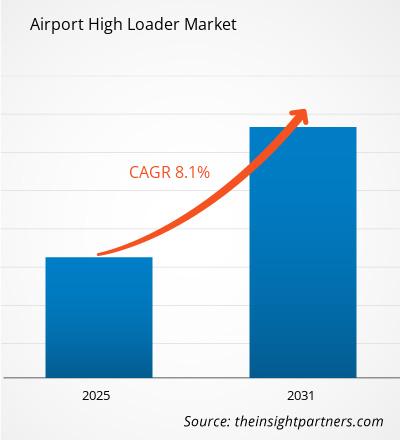Der Markt für Flughafen-Hochladeanlagen wird voraussichtlich von 2026 bis 2034 mit einer durchschnittlichen jährlichen Wachstumsrate (CAGR) von 8,1 % wachsen. Die Marktbedingungen entwickeln sich stetig weiter und eröffnen den Akteuren neue Chancen. Insgesamt zeichnet sich ein stabiles Marktumfeld mit langfristigem Wachstumspotenzial ab.
Der Bericht ist nach Typ (Scheren-, Säulen- und Teleskoptyp) gegliedert. Er enthält außerdem Analysen basierend auf der Anwendung (zivile Flughäfen, Militär-/Bundesflughäfen, private Flughäfen). Die globale Analyse wird weiter auf regionaler Ebene und für wichtige Länder aufgeschlüsselt. Der Bericht gibt den Wert der oben genannten Analysen und Segmente in US-Dollar an.
Zweck des Berichts
Der Bericht „Flughafen-Hochladermarkt“ von The Insight Partners beschreibt die aktuelle Marktlage und das zukünftige Wachstum, die wichtigsten Triebkräfte, Herausforderungen und Chancen. Er bietet Einblicke für verschiedene Akteure im Markt, wie zum Beispiel:
- Technologieanbieter/Hersteller: Um die sich entwickelnde Marktdynamik zu verstehen und die potenziellen Wachstumschancen zu erkennen, damit sie fundierte strategische Entscheidungen treffen können.
- Investoren: Um eine umfassende Trendanalyse hinsichtlich der Marktwachstumsrate, der finanziellen Marktprognosen und der Chancen entlang der gesamten Wertschöpfungskette durchzuführen.
- Regulierungsbehörden: Zur Regulierung von Richtlinien und Überwachungstätigkeiten auf dem Markt mit dem Ziel, Missbrauch zu minimieren, das Vertrauen der Anleger zu erhalten und die Integrität und Stabilität des Marktes zu wahren.
Marktsegmentierung für Flughafen-Hochlader
- Scherenart
- Spaltentyp
- Teleskoptyp
Anwendung
- Zivile Flughäfen
- Flughäfen des Militärs/der Bundesregierung
- Privatflughäfen
Sie erhalten eine kostenlose Anpassung aller Berichte – einschließlich Teilen dieses Berichts, Länderanalysen und Excel-Datenpaketen – sowie attraktive Angebote und Rabatte für Start-ups und Universitäten.
Markt für Flughafen-Hochlader: Strategische Einblicke

-
Ermitteln Sie die wichtigsten Markttrends dieses Berichts.Diese KOSTENLOSE Probe beinhaltet eine Datenanalyse, die von Markttrends bis hin zu Schätzungen und Prognosen reicht.
Wachstumstreiber des Marktes für Flughafen-Hochlader
- Steigendes Flug- und Frachtaufkommen: Der Hauptwachstumstreiber für diesen Markt liegt im steigenden Passagier- und Frachtaufkommen. Fluggesellschaften expandieren aufgrund des zunehmenden Passagier- und Frachtverkehrs und benötigen daher mehr effiziente Bodenabfertigungsgeräte, wie beispielsweise Flughafen-Hochlader, für das zeitnahe und sichere Be- und Entladen von Flugzeugen.
- Technologische Fortschritte bei Bodenabfertigungsgeräten: Verbesserungen in der Technologie von Hochladern, wie z. B. optimierte Hydrauliksysteme und erweiterte Sicherheitsmerkmale, bilden die Grundlage für das stetige Marktwachstum. Diese Fortschritte erhöhen Effizienz, Sicherheit und Zuverlässigkeit beim Betrieb am Flughafenboden und machen Hochlader somit für Flughafenbetreiber attraktiver.
Markt für Flughafen-Hochlader: Zukunftstrends
- Automatisierung und intelligente Technologien: Der Trend zur Automatisierung des Flughafenbetriebs zeigt sich auch im Markt für Hochleistungsverladeanlagen. Intelligente Technologien wie das Internet der Dinge (IoT) und automatisierte Steuerungssysteme verbessern Effizienz und Sicherheit bei der Bodenabfertigung. Daher sind moderne Verladeanlagen besonders gefragt.
- Individualisierung und modulare Bauweise: Der Einsatz von kundenspezifischen Hochleistungs-Transportanlagen, die auf die spezifischen Bedürfnisse eines Flughafens zugeschnitten werden können, wird weiter zunehmen. Diese Flexibilität kann Flughäfen dabei unterstützen, besser auf veränderte Anforderungen an die Bodenabfertigung zu reagieren, indem die Ausrüstung angepasst wird. Dadurch werden Effizienz und Servicequalität im dynamischen Luftfahrtumfeld verbessert.
Marktchancen für Flughafen-Hochlader
- Elektrische und hybride Schwerlasttransporter: Nachhaltigkeitsinitiativen bieten großes Potenzial für die Entwicklung elektrischer und hybrider Schwerlasttransporter, da Nachhaltigkeit an Flughäfen einen hohen Stellenwert einnimmt. Der Trend zu umweltfreundlicheren Technologien kann Herstellern helfen, emissionsfreie Lösungen zu entwickeln und die Betriebskosten zu senken.
- Infrastrukturelles Wachstum von Flughäfen in Schwellenländern: Der Markt für Flughafen-Hochladeflugzeuge entwickelt sich aufgrund der rasanten Urbanisierung und des Wirtschaftswachstums in Schwellenländern schnell. Mit den steigenden Investitionen in neue und modernisierte Flughafeninfrastrukturen sowie dem zunehmenden Flugverkehr und der verbesserten betrieblichen Effizienz steigt der Bedarf an Hochladeflugzeugen.
Markt für Flughafen-Hochlader: Regionale Einblicke
Die regionalen Trends und Einflussfaktoren auf den Markt für Flughafen-Hochlader im gesamten Prognosezeitraum wurden von den Analysten von The Insight Partners eingehend erläutert. Dieser Abschnitt behandelt außerdem die Marktsegmente und die geografische Verteilung des Marktes für Flughafen-Hochlader in Nordamerika, Europa, Asien-Pazifik, dem Nahen Osten und Afrika sowie Süd- und Mittelamerika.
Marktbericht für Flughafen-Hochlader – Umfang
| Berichtattribute | Details |
|---|---|
| Marktgröße im Jahr 2025 | XX Millionen US-Dollar |
| Marktgröße bis 2034 | XX Millionen US-Dollar |
| Globale durchschnittliche jährliche Wachstumsrate (2026 - 2034) | 8,1 % |
| Historische Daten | 2021-2024 |
| Prognosezeitraum | 2026–2034 |
| Abgedeckte Segmente |
Nach Typ
|
| Abgedeckte Regionen und Länder |
Nordamerika
|
| Marktführer und wichtige Unternehmensprofile |
|
Marktdichte bei Flughafen-Hochverladeanlagen: Auswirkungen auf die Geschäftsdynamik verstehen
Der Markt für Flughafen-Hochladeanlagen wächst rasant, angetrieben durch die steigende Nachfrage der Endverbraucher. Gründe hierfür sind unter anderem sich wandelnde Verbraucherpräferenzen, technologische Fortschritte und ein wachsendes Bewusstsein für die Vorteile des Produkts. Mit steigender Nachfrage erweitern Unternehmen ihr Angebot, entwickeln innovative Lösungen, um den Kundenbedürfnissen gerecht zu werden, und nutzen neue Trends, was das Marktwachstum zusätzlich beflügelt.

- Verschaffen Sie sich einen Überblick über die wichtigsten Akteure im Markt für Flughafen-Hochlader.
Wichtigste Verkaufsargumente
- Umfassende Abdeckung: Der Bericht beinhaltet eine umfassende Analyse der Produkte, Dienstleistungen, Typen und Endnutzer des Marktes für Flughafen-Hochlader und bietet so ein ganzheitliches Bild.
- Expertenanalyse: Der Bericht basiert auf dem fundierten Wissen von Branchenexperten und Analysten.
- Aktuelle Informationen: Der Bericht gewährleistet Geschäftsrelevanz durch die Berücksichtigung aktueller Informationen und Datentrends.
- Anpassungsmöglichkeiten: Dieser Bericht kann an die spezifischen Anforderungen des Kunden angepasst werden und sich optimal in die Geschäftsstrategien einfügen.
Der Forschungsbericht zum Markt für Flughafen-Hochlasttransporter kann daher maßgeblich dazu beitragen, die Branchensituation und die Wachstumsaussichten zu entschlüsseln und zu verstehen. Auch wenn einige berechtigte Bedenken bestehen, überwiegen die Vorteile dieses Berichts insgesamt die Nachteile.
- Historische Analyse (2 Jahre), Basisjahr, Prognose (7 Jahre) mit CAGR
- PEST- und SWOT-Analyse
- Marktgröße Wert/Volumen – Global, Regional, Land
- Branchen- und Wettbewerbslandschaft
- Excel-Datensatz
Aktuelle Berichte
Erfahrungsberichte
Grund zum Kauf
- Fundierte Entscheidungsfindung
- Marktdynamik verstehen
- Wettbewerbsanalyse
- Kundeneinblicke
- Marktprognosen
- Risikominimierung
- Strategische Planung
- Investitionsbegründung
- Identifizierung neuer Märkte
- Verbesserung von Marketingstrategien
- Steigerung der Betriebseffizienz
- Anpassung an regulatorische Trends






















 Kostenlose Probe anfordern für - Markt für Flughafen-Hochlader
Kostenlose Probe anfordern für - Markt für Flughafen-Hochlader